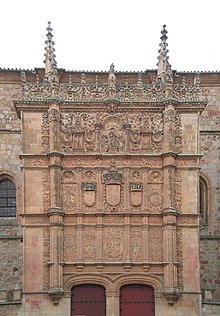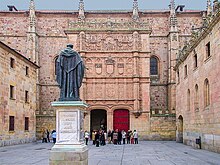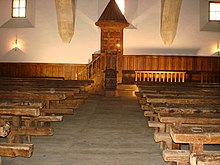University of Salamanca
Universidad de Salamanca | |
 Seal of the University of Salamanca | |
| Latin:Universitas Studii Salamanticensis | |
| Motto | Omnium scientiarum princeps Salmantica docet(Latin) |
|---|---|
Motto in English | Salamanca is foremost in teaching all the sciences |
| Type | Public |
| Established | 1218[1] |
Academic affiliations | EUA,Coimbra Group |
| Rector | Ricardo Rivero Ortega |
Academic staff | 2,453[2] |
Administrative staff | 1,252[2] |
| Students | 30.000 |
| 2,240[3] | |
| Location | ,, 40°57′41″N05°40′00″W/ 40.96139°N 5.66667°W |
| Campus | Urban/College town |
| Colours | Carmine |
| Website | www |
 | |
| University rankings | |
|---|---|
| Global – Overall | |
| ARWUWorld[4] | 501–600 (2023) |
| QSWorld[5] | =534 (2024) |
| THEWorld[6] | 801–1000 (2024) |
| USNWRGlobal[7] | =770 (2023) |





TheUniversity of Salamanca(Spanish:Universidad de Salamanca) is a Spanishpublicresearch university,located inSalamanca,in the autonomous community ofCastile and León.It was founded in 1218 byKing Alfonso IX.It is the oldest university in theHispanic worldand one of the oldest in the worldin continuous operation.It has over 30,000 students from 50 different nationalities.[8]
History[edit]
This sectionneeds additional citations forverification.(August 2021) |
Prior to the foundation of the university, Salamanca was home to a cathedral school, known to have been in existence by 1130. The university was founded as astudium generaleby theLeonese kingAlfonso IXin 1218 as thescholas Salamanticae,with the actual creation of the university (or the transformation of the existing school into the university) occurring between August 1218 and the following winter.[1]A furtherroyal charterfrom King Alfonso X, dated 8 May 1254, established rules for the organisation andfinancial endowmentof the university, and referred to it for the first time by that name.[9]Apapal bullofAlexander IVin 1255 confirmed the Royal Charter of Alfonso X and granted universal recognition to the university's degrees.[10]
The historical phrasesQuod natura non dat, Salmantica non praestat(what nature does not give, Salamanca does not lend, in Latin) andMultos et doctissimos Salmantica habet(many and very versed Salamanca has) give an idea of the prestige the institution rapidly acquired.[11][failed verification]
In the reign of KingFerdinand II of Aragonand QueenIsabella I of Castile,theSpanishgovernment was revamped. Contemporary with theSpanish Inquisition,the expulsion of theJewsand Muslims, and the conquest ofGranada,there was a certain professionalization of the apparatus of the state. This involved the massive employment of "letrados", i.e., bureaucrats and lawyers, who were "licenciados" (university graduates), particularly, ofSalamanca,and the newly foundedUniversity of Alcalá.These men staffed the various councils of state, including, eventually, theConsejo de IndiasandCasa de Contratacion,the two highest bodies in metropolitan Spain for the government of theSpanish Empire in the New World.[citation needed]
WhileColumbuswas lobbying the King and Queen for a contract to seek out a western route to the Indies, he made his case to a council of geographers at the University of Salamanca. While the geographers were skeptical of Columbus and his voyage calculations, the University of Salamanca always defended the theory of unknown territories to the west, and supported Columbus' voyage, believing that new territories may be discovered. In the next century, the morality and laws ofcolonizationin theIndieswere debated by theSchool of Salamanca,along with the development of the study ofscience,geographyandcartographyof theAmericas,and as well as the study of general subjects ofeconomics,philosophyandtheology.[citation needed]
LikeOxfordandCambridge,Salamanca had a number of colleges (Colegios Mayores). These were founded as charitable institutions to enable poor scholars to attend the university. By the eighteenth century they had become closed corporations controlled by the families of their founders, and dominated the university between them. Most were destroyed by Napoleon's troops. In the 19th century, the Spanish government dissolved the university's faculties ofcanon lawandtheology.They were later reestablished in the 1940s as part of thePontifical University of Salamanca.[citation needed]
Related affairs[edit]
The faculty renovated the theology department, laid the foundation for modern-day law, international law, modern economic science and actively participated in theCouncil of Trent.The school's mathematicians studied thecalendar reform, commissioned by Pope Gregory XIIIand proposed the solution that was later implemented. By 1580, 6,500 new students had arrived at Salamanca each year, amongst the graduates were state officials of the Spanish monarchy administration. It was also during this period when the first female university students were probably admitted,Beatriz GalindoandLuisa de Medrano,the latter probably being the first woman ever to give classes at a university.[12]
Sorcery[edit]
In popular belief, the university was associated with sorcery. A certain cave in Salamanca was considered the site of a school of black magic. In Spanish, Salamanca may mean "cave", "an evil iguana" and "hand trick"[13]and thesalamanquesa(Tarentola mauritanica,the Spanish name is also derived from "salamander") is a reptile with magical attributes in Spanish tradition.[14] InRomanian folklore,the devil runs a school of black magic namedScholomance.
The name is derived from "Salamanca" and the wise king "Solomon".[15][16]
Present day[edit]
Salamanca draws undergraduate and graduate students from across Spain and the world; it is the top-ranked university in Spain based on the number of students coming from otherregions.[17]It is also known for its Spanish courses for non-native speakers, which attract more than two thousand foreign students each year.[18]
Today, the University of Salamanca is an important center for the study of humanities and is particularly noted for its language studies, as well as in laws and economics. Scientific research is carried out in the university and research centers associated with it, such as at the Centro de Investigación del Cáncer [Cancer Research Centre],[19]Instituto de Neurociencias de Castilla y León or INCyL [Institute of Neuroscience of Castile and León],[20]Centro de Láseres Pulsados Ultracortos Ultraintensos [Ultrashort Ultraintense Pulse Lasers Centre]. It is one of only twoHispanophoneuniversities in the world that have aMoUwith theUnited Nationsto train language professionals for the organization.[21]In conjunction with theUniversity of Cambridge,the University of Salamanca co-founded theAssociation of Language Testers in Europe(ALTE) in 1989.
In 2018, the institution celebrated its eighth centennial.[22]
Library[edit]
The library holds about 906,000 volumes.[23]
Notable people[edit]
Notable staff[edit]
- Juan de Galavís,professor of theology; later becameArchbishop of Santo DomingoandArchbishop of Bogotá
- Francisco Elías de Tejada y Spínola,professor of Philosophy of Law and Natural Law
- Enrique Gil Robles,professor of Natural Law
- Paul Nuñez Coronel(d.1534), professor of Hebrew
- Miguel de Unamuno,writer
- Beatriz Galindo,(d. 1534), professor of Latin and rhetoric
- Luis de Medrano,(d. 1527) rector of the University of Salamanca around 1511–12
- Luisa de Medrano,(d. 1527) professor of Latin. The secondary school in Salamanca, IES Lucia de Medrano was named after her.
- García de Medrano y Álvarez de los Ríos(d. 1683) professor of Canon law, property, Sextus Decretalium and Clementines
- Domingo de Medrano y Mendizabal(d. 1672) rector of the University of Salamanca in 1668–69
- Garcia de Medrano y Mendizabal(d. 1695) rector of the University of Salamanca in 1668–69
Notable students[edit]
- Miguel de Cervantes,author
- Luis de Góngora
- Fray Luis de León
- Francisco de Vitoria
- Pedro Calderón de la Barca
- Bartolomé de Las Casas
- Beatriz Galindo
- Miguel de Unamuno
- Bernardino de Sahagún
Other notable students and academic teachers include:
- Gustavo Petro,President of Colombia
- Roberto Urdaneta Arbeláez,President of Colombia
- Aristides Royo,President of Panama
- Francisco J. Ayala
- Susana Marcos Celestino
- Abraham Zacuto
- Ignacio Baleztena Ascárate
- Esteban de Bilbao Eguía
- Domingo de Soto
- Melchor Cano
- Francisco Suárez
- St. John of the Cross
- Antonio de Nebrija
- Gaspar de Guzmán, Count-Duke of Olivares
- Gaspar Sanz
- Pedro Gómez Labrador, Marquis of Labrador
- Cardinal Mazarin
- Mateo Alemán
- Diego de Torres Villarroel
- Pedro Salinas
- Adolfo Suárez
- Juan Zarate
- Manuel Belgrano
- Luis de Onís
- Pedro Nunes
- Simón de Rojas
- Antonio Tovar
- Gaspar Cervantes de Gaeta
- Xavier Becerra
- Ángela Abós Ballarín
- Juan Pizarro Navarrete
See also[edit]
Notes and references[edit]
- ^abÁlvarez Villar, Julián (1972).La Universidad de Salamanca: arte y tradiciones.Universidad de Salamanca. p. 13.ISBN847481751X.
- ^abUniversity of Salamanca."Personal"(in Spanish). Archived fromthe originalon 2009-03-25.Retrieved2008-09-15.
- ^University of Salamanca."Estudiantes"(in Spanish). Archived fromthe originalon 2009-03-25.Retrieved2008-09-15.
- ^"ARWU World University Rankings 2034".shanghairanking.Retrieved26 August2022.
- ^"QS World University Rankings 2024".topuniversities.19 June 2023.Retrieved26 August2023.
- ^"World University Rankings".timeshighereducation.6 August 2023.Retrieved26 August2023.
- ^"U.S. News Education: Best Global Universities 2022-23".Retrieved23 November2023.
- ^"Ven a la USAL: futuros estudiantes | Universidad de Salamanca".usal.es.Retrieved2022-08-01.
- ^Álvarez Villar, Julián (1972).La Universidad de Salamanca: arte y tradiciones.Universidad de Salamanca. p. 15.ISBN847481751X.
- ^"Historia"(in Spanish). University of Salamanca.Retrieved14 August2021.
- ^VIII Centenario de la Universidad de Salamanca - Reseña Histórica de la Universidad de Salamanca:.Centenario.usal.es. Retrieved on 2013-09-05.
- ^Montaño Montero, Luisa, «Humanistas en la Corte de Isabel la Católica, Luisa de Medrano, ¿Primera catedrática en una universidad europea?», enCuadernos sobre Vico27 (2013), p. 132.
- ^"salamanca".Diccionario de la lengua española(in Spanish). RAE-ASALE. 2020.Retrieved14 November2021.
- ^"salamanquesa".Diccionario de la lengua española(in Spanish). RAE-ASALE. 2020.Retrieved14 November2021.
- ^Gaster, Moses(1884)."Scholomonar, d. i. er Grabancijaš dijak nach der Voksüberlieferung er Rumänen".Archiv für slavische Philologie(in German).VII:288–289.
- ^Oișteanu, Andrei(1999).Cosmos Vs. Chaos: Myth and Magic in Romanian Traditional Culture: a Comparative Approach.Translated by Mirela Adăscăliţei; Alexander Drace-Francis. Romanian Cultural Foundation Publishing House. p. 221.ISBN9-789-7357-7198-0.:"În 1884, Moses Gaster a acordat apelativului în discuţie o etimologie combinată:" Şolomonar este rezultatul dintre şolomanţă [de la Salamanca – n. A.O.] + solomonie [de la Solomon – n. A.O.] "
- ^"Archived copy"(PDF).Archived fromthe original(PDF)on 2012-02-28.Retrieved2009-10-21.
{{cite web}}:CS1 maint: archived copy as title (link) - ^La USAL inaugura los cursos de verano con 2.000 estudiantes extranjeros.elmundo.es. Retrieved on 2013-09-05.
- ^"Home".cicancer.org.
- ^(in Spanish)INCyL.INCyL. Retrieved on 2013-09-05.
- ^"MoU Network".United Nations.Retrieved2020-12-28.
- ^VIII Centenario de la Universidad de Salamanca - VIII Centenario de la Universidad de Salamanca.Centenario.usal.es. Retrieved on 2013-09-05.
- ^Spain – Libraries and museums
Literature[edit]
- Manuel Fernández Álvarez, Luis E. Rodríguez San Pedro & Julián Álvarez Villar,The University of Salamanca,Ediciones Universidad de Salamanca, 1992.ISBN84-7481-701-3.
External links[edit]
- Official website

- VIII Centenario website
- University of Salamanca language courses. Official spanish courses website
- Language courses in Salamanca University, marketed by a private company, Accom Consulting Spain S. L., an authorized University agent
- Herbermann, Charles, ed. (1913)..Catholic Encyclopedia.New York: Robert Appleton Company.
- Scholars and Literati at the University of Salamanca (1218–1800),inRepertorium Eruditorum Totius Europae/RETE.
